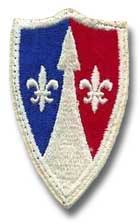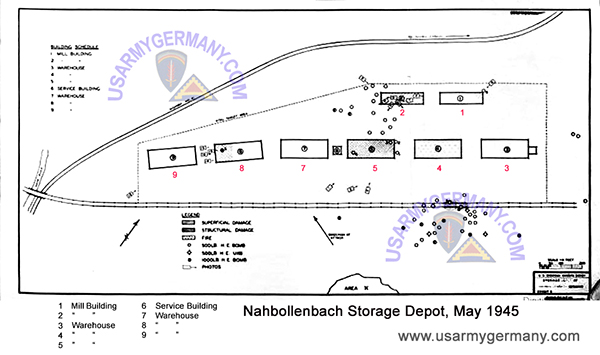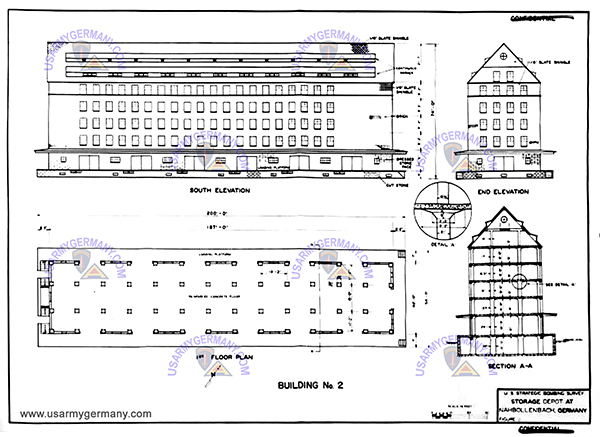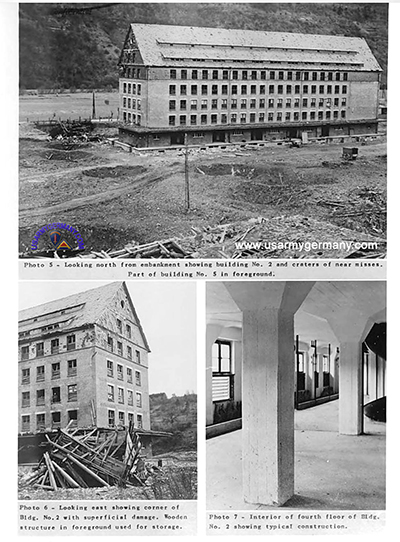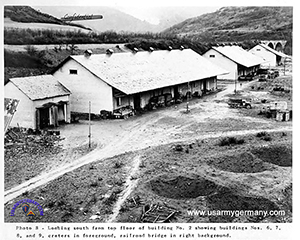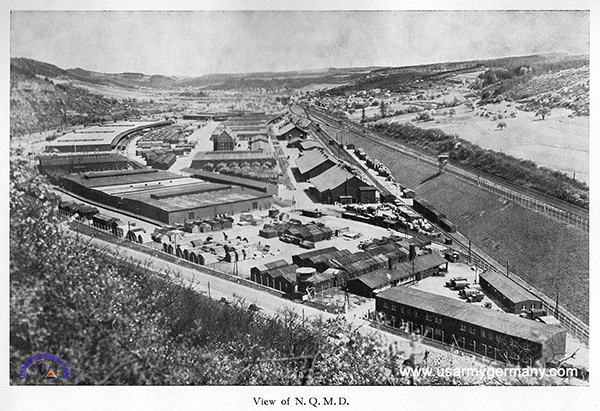| If you do
NOT see the Table of Contents frame to the left of this page, then
Click here to open 'USArmyGermany' frameset |
|||||||||||||||||||||||||
Nahbollenbach Army Depot |
|||||||||||||||||||||||||
|
|
|||||||||||||||||||||||||
|
|||||||||||||||||||||||||
|
|
|||||||||||||||||||||||||
| Depot History | |||||||||||||||||||||||||
|
|||||||||||||||||||||||||
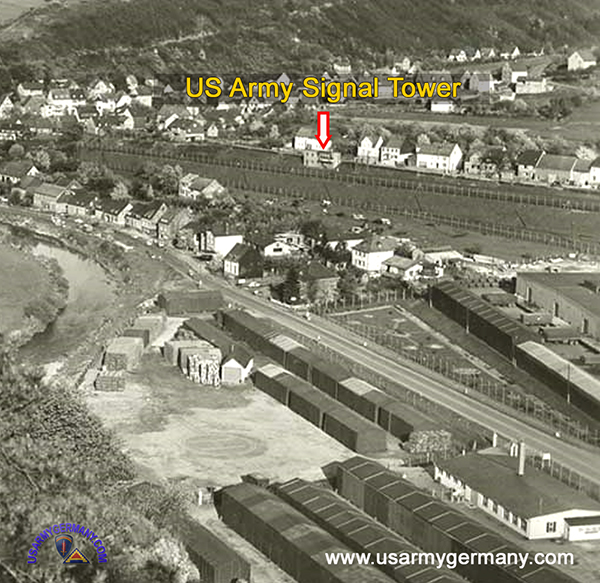 |
|||||||||||||||||||||||||
|
|||||||||||||||||||||||||
| (Source: Storage Depot at Nahbollenbach, Germany, Physical Damage Division Report No. 25, U. S. Strategic Bombing Survey, 1947) | |||||||||||||||||||||||||
| The German military depot was used for processing and storage of grain and provided 161,000 sq ft of storage space. Six of the buildings were single story warehouses and similar in construction and size. A smaller structure of similar construction served as a service building. Two additional buildings were reinforced concrete structures and were originally scheduled to each have six stories and a basement. However, only one was completed as planned. The construction of the other stopped at the second floor level and had a temporary roof erected over that floor. There were also several temporary wooden structures. |
|||||||||||||||||||||||||
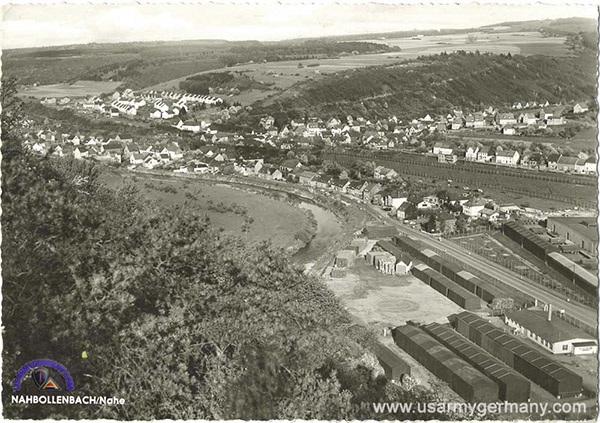 Northeatern area of Nahbollenbach Army Depot, 1960s |
|||||||||||||||||||||||||
| 1950 - 1986 | |||||||||||||||||||||||||
| (Source: Welcome to General Support Center, Kaiserslautern. Compiled by GSCK in 1989) | |||||||||||||||||||||||||
| Nahbollenbach
was a German Army depot until the end of World War II. It was turned over (at the end of WWII) to the French Army until 1950. In 1950 it was turned over to the US Army. Construction on all the large warehouses began in 1951, and was completed in December 1952. |
|||||||||||||||||||||||||
|
|||||||||||||||||||||||||
(Source: Email from
Dave Willis) |
|||||||||||||||||||||||||
Col Hines was the Depot Commander when I arrived there in Nov 1952. ADDITIONAL INFORMATION: |
|||||||||||||||||||||||||
I don't know if this is important enough to note but I noticed (from the Depot drawing) that the numbers of the warehouses have been changed since I left in 1956. I don't remember the numbers for the whole depot but I do remember the warehouses I was in charge of and those on either side:. The warehouse numbered 2 in the drawing was Warehouse #1 in 1952. The warehouse numbered 1-3 was Warehouse #2, warehouse numbered 1-2 was Warehouse #2A, warehouse numbered 1-1 was Warehouse #3. I was the NCO in charge of warehouse 2, 2A & 3 before I returned to the States in 1956. Warehouse numbered 5 in drawing was originally Warehouse #4. When I arrived in Nov 1952 there were only twelve warehouses, several more were built before I left in 1956. Also there was a Lt Col Grisham in charge of Warehouse Operations when I left in 1952. |
|||||||||||||||||||||||||
The original twelve warehouses were: Warehouse #12 shipped Less Than Case lots (LCL Shipments) . |
|||||||||||||||||||||||||
| Early/mid 1950s | |||||||||||||||||||||||||
| (Source: "Souvenir of N.Q.M.D. - St. K., Idar Oberstein, Germany," undated brochure, Webmaster's collection) | |||||||||||||||||||||||||
| Brochure includes photos of Strassburg Kaserne. Click here to view those image. | |||||||||||||||||||||||||
1964 |
|||||||||||||||||||||||||
(Source: Email from Hartmut Wettmann, son of Arthur Wattmann, civilian employee at Nahbollenbach Depot) |
|||||||||||||||||||||||||
1966 |
|||||||||||||||||||||||||
(Source: Email from Ron Proffitt) |
|||||||||||||||||||||||||
I was stationed at Strassburg Kaserne from Christmas Eve 1966 (yes, I arrived on Christmas Eve) as an E-2 and was extremely nervous. We flew into Frankfurt from Ft. Dix, New Jersey IIRC....long time ago. Three of us boarded a train for Idar-Oberstein, (West) Germany. Each of us did not know one another other than we were going to Strassburg K. We arrived at the train station about midnight and there was a small phone booth that had a sign on it with the number to call for pickup by US Army; we called and about 20 minutes later a jeep or other military vehicle arrived. Driver asked to see our papers. When ok, we hopped in and headed into the night on a road that had NO straight sections in it at all (remember I'm from Kansas and we can see for miles and our roads are as straight as arrows!). The driver took us up to Strassburg Kaserne and dumped us out at the first barracks. We checked in and were assigned to #4 (clear at the other end of the street, about 1/4 mile) so we carried every thing we owned (not much) and checked in. Were put up on the 4th floor (attack area) with nice rooms and were told at what time Chow would be served at breakfast across the street and about halfway back down the street. We were in a "Holding Company" until our orders arrived about 3-4 days later which assigned each of us our barracks. Since I was a 71N20 (MOS - Transportation Movements Specialist), I was put into the HQ Company on the other end of the street just inside the Main Gate. The others were put into the other Company's according to their MOS (I think both were "box humpers", warehouse guys) and really never saw either one of them again other than off and on at the PX. |
|||||||||||||||||||||||||
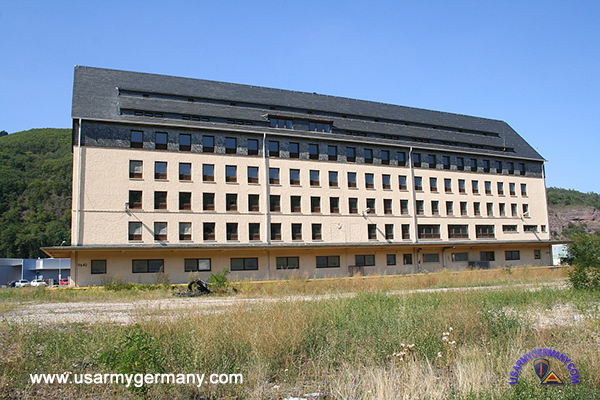 Bldg #9640, Nahbollenbach Depot, 2005 (Johnny Chocholaty) |
|||||||||||||||||||||||||
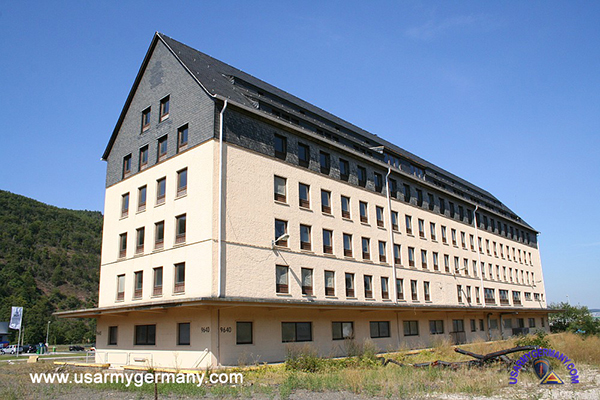 Bldg #9640, Nahbollenbach Depot, 2005 (Johnny Chocholaty) |
|||||||||||||||||||||||||
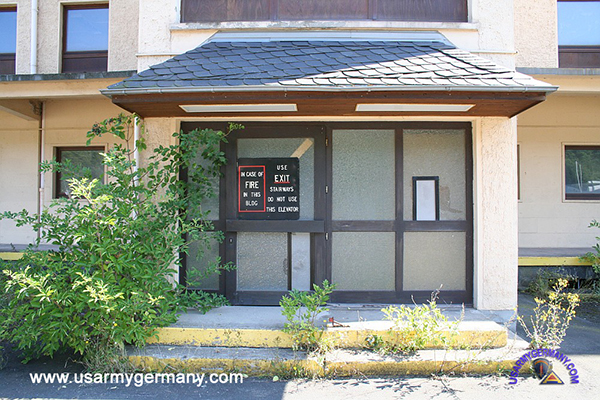 Bldg #9640, Nahbollenbach Depot, 2005 (Johnny Chocholaty) |
|||||||||||||||||||||||||
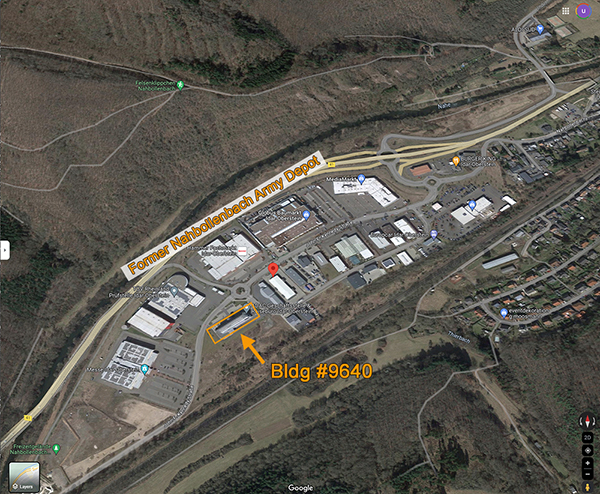 Location of former Bldg #9640 in the new commercial park (aerial - GOOGLE) |
|||||||||||||||||||||||||
The Nahbollenbach Depot (at the time known as the European Redistribution Center) was released to the German government in 1997. The former installation was demolished with the exception of Bldg #9640 and converted to a commercial park, "Gewerbepark Nahetal." |
|||||||||||||||||||||||||
| If you have more
information on the history or organization of the Nahbollenbach Army
Depot, please contact me |
|||||||||||||||||||||||||
|
|
|||||||||||||||||||||||||
| RSAN Organization and Mission | |||||||||||||||||||||||||
| (Source: Welcome to General Support Center, Kaiserslautern. Compiled by GSCK in 1989) | |||||||||||||||||||||||||
|
|||||||||||||||||||||||||
|
MISSION STATISTICS
(as of Jan 1989)
|
|||||||||||||||||||||||||
|
|||||||||||||||||||||||||
|
GENERAL
INFORMATION
Nearest Autobahn located approximately 28 km at Freisen. Nahbollenbach Storage Area is situated on 96 acres of land. Nahbollenbach Storage Area has - 71,958 sq yds of roadway; 6.7 miles of railroad; 3.11 miles of fenceline. |
|||||||||||||||||||||||||
|
|
|||||||||||||||||||||||||
| Winterhauch Storage Site | |||||||||||||||||||||||||
|
(Source:
Email from Michael Sheetz, 7th CEC, 1974-76)
|
|||||||||||||||||||||||||
|
|
|||||||||||||||||||||||||
| Per USAREUR instruction, the Group developed a facilities plan with all new and modern shops, storage facilities with weapon areas, test tracks and vehicle wash racks. All were accepted but only one built while I was there, a modern tank repair shop. When I left 7th CEC, I became Group Director for Supply and then Group XO. This entire time was spent opening CEBN. While XO, I was responsible for sites in England; 1 at Hythe (fleet storage) and 1 at Liverpool (depot facilities). I don’t remember many names. COL. Patrick Roddy, later MG; LTC Roland Shawl, later COL. Lots of fun, lots of work. |
|||||||||||||||||||||||||
|
|
|||||||||||||||||||||||||
| Air Item Maintenance Shop | |||||||||||||||||||||||||
(Source:
STARS & STRIPES, May 24, 1971) |
|||||||||||||||||||||||||
| The Air Item Maintenance Shop (AIMS) at Nahbollenbach Depot is responsible for repairing huge cargo parachutes, personnel chutes and other air equipment. The shop also manufactures air-drop components to fix chutes and other equipment when replacement parts are not available. The chief of AIMS is CWO Boyd D. Lee. AIMS services all Army and many Air Force units as well as aerial demonstration teams of both services. More than $1 million worth of air items were processed through the maintenance shop in 1970. Ten seamstresses busily patch and sew the chutes that get the go-ahead nod from one of the seven EM's who act as inspectors. All of these enlisted men are parachute riggers and are jump-qualified. Once repair work has been completed, the chute is returned for repacking to the unit that sent it in for repair. A parachute normally has a 10-year or 100-jump life expectancy. Each chute received in the shop is classified according to the number of jumps made. Repairs for the chute are determined and the total cost of those repairs is estimated and compared to the remaining life expectancy of the chute. If determined to be economical, the repairs are made. There is no limit as to the size of repairs or number of sections of the chute to be replaced as long as they are cost-practical. Costs of (a new) chute ranges from about $5 for a pilot chute (used to pull out regular chutes) to $1,200 for a 100-foot cargo heavy-drop chute. In 1970, a Cannibalization Section was set up in AIMS to strip the chutes that could not be economically repaired of usable parts such as metal fittings, before they are sent to property disposal. |
|||||||||||||||||||||||||
